AI in Gaming: From NPCs to Procedural Content Generation

The Evolution of AI in Gaming
The intersection of artificial intelligence (AI) and gaming has led to remarkable advancements in interactive entertainment. From the early days of simplistic NPCs (non-player characters) to sophisticated procedural content generation, AI is revolutionizing the gaming landscape. This article delves into the various applications of AI in gaming, showcasing its evolution and impact on player experiences.
NPCs: Bringing Virtual Worlds to Life
1. NPC Behavior and Interaction:
- NPCs serve as the backbone of many gaming experiences, providing players with allies, enemies, and quest givers.
- AI algorithms govern NPC behavior, allowing characters to exhibit lifelike traits such as decision-making, pathfinding, and dialogue generation.
2. Adaptive AI:
- Advanced NPCs adapt their behavior based on player actions, creating dynamic and immersive gameplay experiences.
- Examples include enemies that learn from player strategies and allies that respond to the player's emotional cues.
Procedural Content Generation: Endless Possibilities
1. Dynamic Environments:
- AI-driven procedural generation techniques create vast, ever-changing game worlds without the need for manual design.
- Games like "Minecraft" utilize procedural generation to generate unique landscapes, ensuring that no two playthroughs are alike.
2. Quests and Missions:
- AI algorithms generate quests, missions, and challenges dynamically, providing players with an endless stream of content.
- Games like "No Man's Sky" use procedural generation to create diverse planetary systems and exploration opportunities.
AI-Driven Game Design: Enhancing Player Experiences
1. Personalized Gameplay:
- AI analyzes player behavior and preferences to tailor gaming experiences to individual players.
- Dynamic difficulty adjustment algorithms ensure that challenges remain engaging and balanced for players of all skill levels.
2. Content Creation Tools:
- AI-powered tools empower game developers to create expansive worlds and intricate gameplay systems more efficiently.
- Platforms like Unreal Engine and Unity integrate AI-driven features for level design, animation, and asset creation.
Real-World Examples
-
"The Elder Scrolls V: Skyrim": The game features NPCs with dynamic schedules and behaviors, creating a vibrant and immersive world for players to explore.
-
"Spelunky": Procedural generation techniques are used to generate randomized levels, ensuring that each playthrough offers unique challenges and surprises.
Future Trends and Challenges
1. Advancements in Machine Learning: AI technologies such as reinforcement learning and neural networks are poised to revolutionize NPC behavior and procedural content generation further.
2. Ethical Considerations: As AI becomes more prevalent in gaming, developers must address concerns related to data privacy, bias, and player manipulation.
AI is reshaping the gaming industry, from the intricacies of NPC behavior to the limitless possibilities of procedural content generation. As AI technologies continue to evolve, gamers can look forward to more immersive and dynamic experiences that push the boundaries of interactive entertainment. By harnessing the power of AI, game developers can create worlds that are not only compelling but also responsive to the unique preferences and actions of each player.














